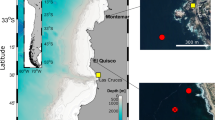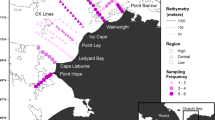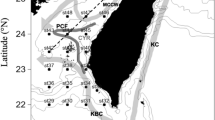Abstract
The present study provides the longest and most intensive plankton and larval fish seasonal variability analysis in the Canary Islands and forms a basis for understanding life cycle scheduling and interactions among species, as well as the potential variability in transport processes of early life stages. Larval fish assemblages were studied weekly at Gran Canaria Island, Canary Islands, from January 2005 to June 2007, which represented two contrasting hydrological and biological periods. The former year was characterized by lower temperature and salinity that increased through 2006 and 2007. In contrast, chlorophyll concentration and mesozooplankton biomass decreased through the same period, especially when only the late winter bloom period was evaluated. However, ichthyoplankton abundance did not exhibit any clear pattern, as larger values were observed during 2006. The larval fish community of this oceanic island, located near the NW African upwelling, was composed of both neritic and oceanic taxa. Two families accounted for almost half of the collected larvae: Clupeidae (21.9%) and Myctophidae (20.5%). Although total larval concentration did not exhibit any seasonal peak linked to changes in zooplankton, the ichthyoplankton composition gradually changed during the year due to the high diversity and extended spawning periods of the fish species represented in samples. “Winter” and “summer” larval assemblages were identified, corresponding to the mixing and stratification periods of the water column, respectively. These assemblages were characterized by changes in the contribution of the most abundant annual taxa (Sardinella aurita, Cyclothone braueri, Ceratoscopelus spp. and Gobids) and by the presence of larvae of winter (Pagellus bogaraveo, Pomacentridae sp1) or summer spawners (Pomacentridae sp2, Trachinus draco, Arnoglossus thori, Tetraodontidae sp1). Upwelling filaments shed from the NW African coast reached the sampling area three times during this study, but changes in the local larval community were only detected in August 2005.






Similar content being viewed by others
References
Arístegui J, Sangrá P, Hernández-León S, Cantón M, Hernández-Guerra A, Kerling JL (1994) Island-induced eddies in the Canary Islands. Deep Sea Res I 41:1509–1525
Arístegui J, Tett P, Hernández-Guerra A, Basterretxea G, Montero MF, Wild K, Sangrá P, Hernández-León S, Cantón M, García-Braun JA, Pacheco M, Barton ED (1997) The influence of island-generated eddies on chlorophyll distribution: a study of mesoscale variation around Gran Canaria. Deep Sea Res I 44:71–96
Arístegui J, Hernández-León S, Montero MF, Gómez M (2001) The seasonal planktonic cycle in coastal waters of the Canary Islands. Sci Mar 65:51–58
Arístegui J, Álvarez-Salgado XA, Barton ED, Figueiras FG, Hernández-León S, Roy C, Santos AMP (2006) Oceanography and fisheries of the Canary Current/Iberian region of the Eastern North Atlantic (18a, E). In: Robinson AR, Brink KH (eds) The Sea. Harvard University Press, Cambridge, pp 877–927
Arístegui J, Barton ED, Álvarez-Salgado XA, Santos AMP, Figueiras FG, Kifani S, Hernández-León S, Mason E, Machú E, Demarq H (2009) Sub-regional ecosystem variability in the Canary Current upwelling. Progr Oceanogr 83:33–48
Barton ED, Arístegui J, Tett P, Cantón M, García-Braun J, Hernández-León S, Nykjaer L, Almeida C, Almunia J, Ballesteros S, Basterretxea G, Escánez J, García-Weill L, Hernández-Guerra A, López-Laatzen F, Molina R, Montero MF, Navarro-Pérez E, Rodríguez JM, van Lenning K, Vélez H, Wild K (1998) The transition zone of the Canary Current upwelling region. Progr Oceanogr 41:455–504
Bauchot M-L, Hureau J-C (1986) Sparidae. In: Whitehead PJP, Bauchot M-L, Hureau J-C, Nielsen J, Tortonese E (eds) Fishes of the north-eastern Atlantic and the Mediterranean. UNESCO, Paris, pp 883–907
Bécognée P, Almeida C, Barrera A, Hernández-Guerra A, Hernández-León S (2006) Annual cycle of clupeiform larvae around Gran Canaria Island, Canary Islands. Fish Oceanogr 15:293–300
Bekker VE (1983) Myctophids of the world oceans. Nakua Press, Moscow
Boehlert GW, Mundy BC (1993) Ichthyoplankton assemblages at seamounts and oceanic islands. Bull Mar Sci 53:336–361
Boehlert GW, Watson W, Sun LC (1992) Horizontal and vertical distributions of larval fishes around an isolated oceanic island in the tropical Pacific. Deep Sea Res I 39:439–466
Braun JG (1980) Estudios de producción en aguas de las Islas Canarias I. Hidrografía, nutrientes y producción primaria. Bol Inst Esp Oceanogr 5:147–154
Braun JG, Real F (1984) Estudios de producción en la bahía de Antequera: una comparación con aguas oceánicas. Bol Inst Esp Oceanogr 291:97–105
Brochier T, Ramzi A, Lett C, Machu E, Berraho A, Freon P, Hernandez-Leon S (2008) Modelling sardine and anchovy ichthyoplankton transport in the Canary Current System. J Plankton Res 30:1133–1146
Brochier T, Colas F, Lett C, Echevin V, Cubillos LA, Tam J, Chlaida M, Mullon C, Fréon P (2009) Small pelagic fish reproductive strategies in upwelling systems: a natal homing evolutionary model to study environmental constraints. Progr Oceanogr 83:261–269
Caballero-Alfonso A, Ganzedo U, Trujillo-Santana A, Polanco J, Santana del Pino A, Ibarra-Berastegi G, Castro-Hernández JJ (2010) Climatic variability and the small-scale trap octopus fishery off Canary Islands (Central East Atlantic). Fish Res 102:258–265
Clarke KR (1993) Non-parametric multivariate analyses of changes in community structure. Aust J Ecol 18:117–143
Clarke KR, Warwick RM (2005) PRIMER-6. Natural Environmental Research Program, Plymouth
Cowen RK, Castro LR (1994) Relation of coral reef fish larval distributions to island scale circulation around Barbados, West Indies. Bull Mar Sci 54:228–244
Cowen RK, Lwiza KMM, Sponaugle S, Paris CB, Olson RB (2000) Connectivity of marine populations: open or closed? Science 287:857–859
Cushing DH (1969) The Regularity of the Spawning Season of Some Fishes. ICES J Mar Sci 33:81–92
Cushing DH (1975) Marine ecology and fisheries. Cambridge University Press, pp 278
Doty MS, Oguri M (1956) The island mass effect. J Cons Int Explor Mer 22:33–37
Doyle MJ, Mier KL, Busby MS, Brodeur RD (2002) Regional variation in springtime ichthyoplankton assemblages in the northeast Pacific Ocean. Progr Oceanogr 53:247–281
Drinkwater K, Lochman S, Taggart C, Thompson K, Frank K (2000) Entrainment of redfish (Sebastes spp.) larvae off the Scotian Shelf. ICES J Mar Sci 57:372–382
Frank KT, Leggett WC (1983) Multispecies larval fish associations: Accident or Adaptation? Can J Aquat Sci 40:754–762
Franquet F, Brito A (1995) Especies de interés pesquero de Canarias. Consejería de Pesca y Transportes del Gobierno de Canarias, Santa Cruz de Tenerife
Galarza JA, Carreras-Carbonell J, Macpherson E, Pascual M, Roques S, Turner GF, Rico C (2009) The influence of oceanographic fronts and early-life-history traits on connectivity among littoral fish species. Proc Natl Acad Sci 106:1473–1478
Gray CA, Miskiewicz AG (2000) Larval fish assemblages in south-east australian coastal waters: seasonal and spatial structure. Est Coast Shelf Sci 50:549–570
Grothues TM, Cowen RK (1999) Larval fish assemblages and water mass history in a major faunal transition zone. Continental Shelf Res 19:1171–1198
Hamner WM, Hauri IR (1981) Effects of island mass: water flow and plankton pattern around a reef in the Great Barrier Reef lagoon, Australia. Limnol Oceanogr 26:1084–1102
Hare JA, Fahay MP, Cowen RK (2001) Springtime icthyoplankton of the slope region off the north-eastern United States of America: larval assemblages, relation to hydrography and implications for larval transport. Fish Oceanogr 10:164–192
Hernández-León S (1988) Algunas observaciones sobre la abundancia y estructura del mesozooplancton en aguas del Archipiélago Canario. Bol Inst Esp Oceanogr 5:109–118
Hernández-León S (1991) Acumulation of mesozooplankton in a wake area as a causative mechanism of “island-mass effect”. Mar Biol 109:141–147
Hernández-León S (1998) Annual cycle of epiplanktonic copepods in Canary Island waters. Fish Oceanogr 7:252–257
Hernández-León S, Almeida C, Bécognée P, Yebra L, Arístegui J (2004) Zooplankton biomass and indices of grazing and metabolism during a late winter bloom in subtropical waters. Mar Biol 145:1191–1200
Hernández-León S, Gómez M, Arístegui J (2007) Mesozooplankton in the Canary Current System: The coastal-ocean transition zone. Progr Oceanogr 74:397–421
Hoşusu B, Ak Y (2002) The ichthyoplankton of Üzmir Bay: a one-year study of fish eggs and larvae. Turk J Vet Anim Sci 26:1033–1042
Iles TD, Sinclair M (1982) Atlantic herring: stock discreteness and abundance. Science 215:627–633
Jones GP, Millcich MJ, Emsile MJ, Lunow C (1999) Self-recruitment in a coral fish population. Nature 402:802–804
La Violette PE (1974) A satellite-aircraft thermal study of the upwelled waters off Spanish Sahara. J Phys Oceanogr 4:676–684
Leis JM (1991) The pelagic phase of coral reef fishes: larval biology of coral reef fishes. In: Sale PF (ed) The ecology fishes on coral reefs. Academic Press, San Diego, pp 183–230
Leis JM (2007) Behaviour as input for modelling dispersal of fish larvae: behaviour, biogeography, hydrodynamics, ontogeny, physiology and phylogeny meet hydrography. Mar Ecol Progr Ser 347:185–193
Lobel PS, Robinson AR (1986) Transport and entrapment of fish larvae by ocean mesoscale eddies and currents in Hawaiian waters. Deep Sea Res I 33:483–500
Lobel PS, Robinson AR (1988) Larval fishes and zooplankton in a cyclonic eddy in Hawaiian waters. J Plankton Res 10:1209–1223
Loeb VJ (1980) Vertical distribution and development of larval fishes in the North Pacific Central Gyre during summer. Fish Bull 77:777–793
Longhurst AR, Pauly D (1987) Ecology of tropical oceans. Academic Press, San Diego
Lovegrove T (1966) The determination of the dry weight of plankton and the effect of various factors on the values obtained. In: Barnes H (ed) Some contemporary studies in marine sciences. George Allen and Unwin Ltd, London, pp 429–467
Machu E, Ettahiri O, Kifani S, Benazzouz A, Makaoui A, Demarcq H (2009) Environmental control of the recruitment of sardines (Sardina pilchardus) over the western Saharan shelf between 1995 and 2002: a coupled physical/biogeochemical modelling experiment. Fish Oceanogr 18:287–300
Macpherson E, Raventos N (2006) Relationship between pelagic larval duration and geographic distribution of Mediterranean littoral fishes. Mar Ecol Progr Ser 327:257–265
McKelvie DS (1989) Latitudinal variation in aspects of the bilogy of Cyclothone braueri and C. microdon (Pisces: Gonostomatidae) in the eastern North Atlantic Ocean. Mar Biol 102:413–424
Miller TJ (2002) Assemblages, communities and species interactions. In: Fuiman LA, Werner RG (eds) Fishery science: the unique contributions of early life stages. Blackwell Science, Oxford, pp 183–205
Moyano M (2009) Temporal and spatial distributions of the ichthyoplankton in the Canary Islands. PhD Thesis, Las Palmas de Gran Canaria
Moyano M, Hernández-León S (2009) Temporal and along-shelf distribution of the larval fish assemblage at Gran Canaria, Canary Islands. Sci Mar 73:85–96
Moyano M, Rodríguez J, Hernández-León S (2009) Larval fish abundance and distribution during the late Winter bloom in the Canary Island waters. Fish Oceanogr 18:51–61
Muhling BA, Beckley LE, Koslow JA, Pearce AF (2008) Larval fish assemblages and water mass structure off the oligotrophic south-western Australian coast. Fish Oceanogr 17:16–31
Olivar MP, Shelton PA (1993) Larval fish assemblages of the Benguela current: Larval fish assemblages and oceanic boundaries. Bull Mar Sci 53:450–474
Pacheco M, Hernández-Guerra A (1999) Seasonal variability of recurrent phytoplankton pigment patterns in the Canary Islands area. Int J Remote Sens 20:1405–1418
Queró JC, Hureau JC, Karrer C, Post A, Saldanha L (1990) Check List of the fishes of the Eastern Tropical Atlantic. JNICT/SEI/UNESCO, Lisbon/Paris/Paris
Rodríguez JM (2000) Fish larvae from the Canary region in autumn. Sci Mar 64:79–85
Rodríguez JM, Hernández-León S, Barton ED (1999) Mesoscale distribution of fish larvae in relation to an upwelling filament off Northwest Africa. Deep Sea Res I 46:1969–1984
Rodríguez JM, Barton ED, Eve L, Hernández-León S (2001) Mesozooplankton and ichthyoplankton distribution around Gran Canaria, an oceanic island in the NE Atlantic. Deep Sea Res I 48:2161–2183
Rodríguez JM, Barton ED, Hernández-León S, Arístegui J (2004) The influence of mesoscale physical processes on the larval fish community in the Canaries CTZ, in summer. Progr Oceanogr 62:171–188
Rodríguez JM, Moyano M, Hernández-León S (2009) The ichthyoplankton assemblage of the Canaries-Africa coastal transition zone: a synthesis. Progr Oceanogr 83:314–321
Rodríguez-Graña L, Castro LR (2003) Ichthyoplankton distribution off the Península Mejillones, Chile (23 ºS, 71 ºW), under variable hydrographic conditions during the austral summer and winter of the 1997 El Niño. Hydrobiologia 501:59–73
Sabatés A (1990) Distribution pattern of larval fish populations in the northwestern Mediterranean. Mar Ecol Progr Ser 59:75–82
Sabatés A, Olivar MP, Salat J, Palomera I, Alemany F (2007) Physical and biological processes controlling the distribution of fish larvae in the NW Mediterranean. Progr Oceanogr 74:355–376
Sangrá P, Auladell M, Marrero-Díaz A, Pelegrí JL, Fraile-Nuez E, Rodríguez-Santana A, Martín JM, Mason E, Hernández-Guerra A (2007) On the nature of oceanic eddies shed by the Island of Gran Canaria. Deep Sea Res I 54:687–709
Sanvicente-Añorve L, Soto L, Espinosa-Fuentes M, Flores-Coto C (2006) Relationship Patterns between Ichthyoplankton and Zooplankton: A Conceptual Model. Hydrobiologia 559:11–22
Sobrinho-Gonçalves L, Isisdro E (2001) Fish larvae and zooplankton biomass around Faial Island (Azores archipelago). A preliminary study of species occurrence and relative abundance. Arquipélago. Life Mar Sci 18A:35–52
Stockley B, Menezes G, Pinho MR, Rogers AD (2005) Genetic population structure in the black-spot sea bream (Pagellus bogaraveo Brünnich, 1768) from the NE Atlantic. Mar Biol 146:793–804
Yentsch CS, Menzel DW (1963) A method for the determination of phytoplankton chlorophyll and phaeophytin fluorescence. Deep Sea Res I 10:221–231
Acknowledgments
The authors would like to thank C. Schmoker, M. L. Nieves and all the colleagues of the Biological Oceanography Group that contributed to field work. Also, J. M. Rodríguez, M. A. Peck and three anonymous reviewers are thanked for valuable comments on the manuscript. This study was supported by the Spanish Ministry of Education and Science through the projects CONAFRICA (Cicyt CTM2004-02319) and LUCIFER (CTM2008-03538) and a FPU fellowship to M. M. (AP 2005-4742).
Author information
Authors and Affiliations
Corresponding author
Additional information
Communicated by X. Irigoien.
Rights and permissions
About this article
Cite this article
Moyano, M., Hernández-León, S. Intra- and interannual variability in the larval fish assemblage off Gran Canaria (Canary Islands) over 2005–2007. Mar Biol 158, 257–273 (2011). https://doi.org/10.1007/s00227-010-1556-8
Received:
Accepted:
Published:
Issue Date:
DOI: https://doi.org/10.1007/s00227-010-1556-8




